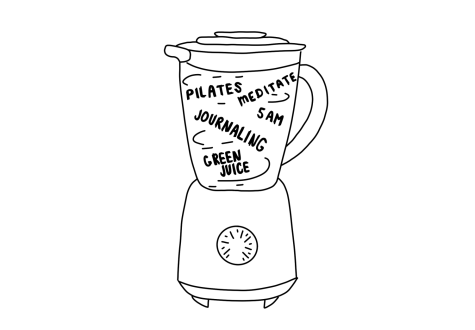“That” girl lifestyle doesn’t workout for most teens
October 21, 2022
From the typical 5:30 a.m. wake-up time, copious amounts of green smoothies, expensive work-out sets and the bizarre emphasis on journaling, “that” girl has dominated social media sites such as Instagram and Tiktok. This trendy female ideal presented by these platforms sets unrealistic standards for beauty, success and fulfillment.
“That” girl is a popular archetype of a female who wakes up early, works out, journals, meditates, recites affirmations and does an assortment of other “wellness” rituals. While there is nothing inherently bad about promoting these healthy habits, the standards they set are unattainable in a plethora of ways. This trend is marketed as being achievable, while for many teenagers it isn’t realistic because of time or financial constraints, among other reasons.

Júlia Ávila, a publicist who represents influencers, described the unrealistic standards that “that” girl presents.
“This ideal has become romanticized. It’s something you can aspire to but it’s practically impossible. Some people with a certain work timetable may be able to [maintain this lifestyle], but for everyone else it can be toxic and overwhelming to see people you admire [preaching] this sort of thing,” Ávila said in an interview with the newspaper El País.
Furthermore, sophomore and TikTok user Kaitlyn Widman explained the challenges of the “that” girl lifestyle. She highlighted the struggle for high school students to prioritize this way of life when they’re also balancing things like sports and extracurriculars.
“If you do sports, that’s at least two hours out of your morning or your afternoon, [so you’re] not going to be able [commit to the “that” girl lifestyle]. Even if you don’t [do extracurriculars or sports], people have jobs,” Widman said. “I think it’s really only realistic for some people [to] achieve that. Things happen and [your life] can’t always be like that.”
Widman also touched on the exclusivity and privilege of the “that” girl narrative.
“[Many] people don’t have the money to pay for that [lifestyle] and that’s a problem because you’re excluding people from these things where they might not have a choice to be a part of it,” Widman said.
This exclusivity poses an issue, as the expectation presented by this ideal, which is heavily targeted at teenagers, relies on them having a steady source of income, which many high schoolers don’t have. Whether it be to pay for the healthful organic food promoted by this lifestyle or the matching workout sets, this way of life is not financially realistic for many teenagers.
Moreover, many teens view ideals, such as “that” girl, on social media as a reality. The “that” girl ideal is just the latest fabrication of real life that is trending. According to a study conducted by Pew Research Center, 15 percent of teenagers think social media alters reality and gives teenagers an unrealistic view of other people’s lives.
While fitting in is a natural goal of many teenagers, social media exacerbates this by showing one-sided narratives that promote lifestyles and ideals that don’t work for everyone. Widman elaborated on this, commenting on her own perspective as a teenager on social media. She points out the toxicity in the one-size fits all approach to beauty and fulfillment.
“People on social media assume that that one thing is this golden standard; what you have to be if you want to be accepted,” Widman stated. “[Beauty, success and fulfillment] look different on every single person. And if you portray it as one thing you’re gonna have no diversity in how people present themselves.”







